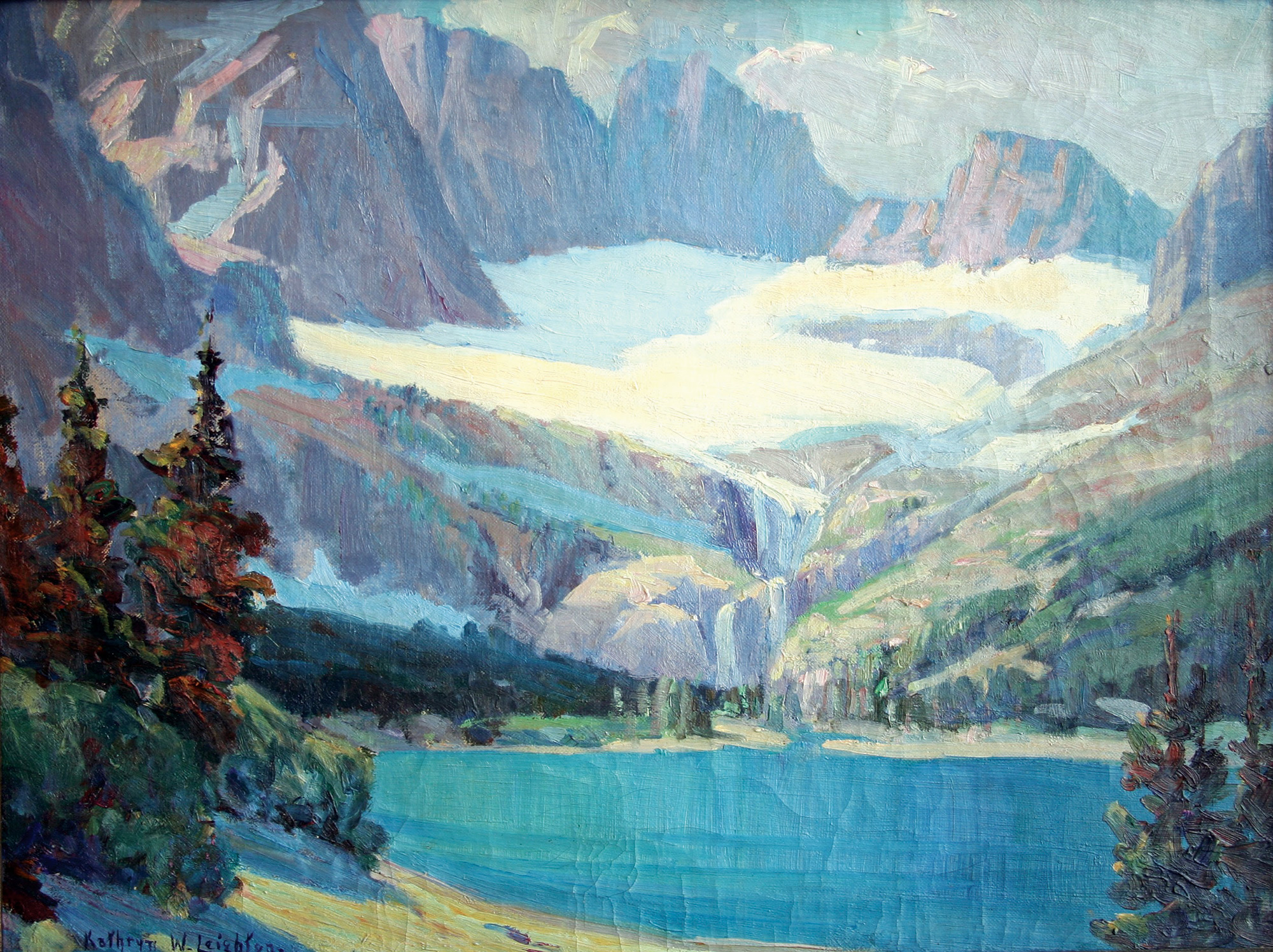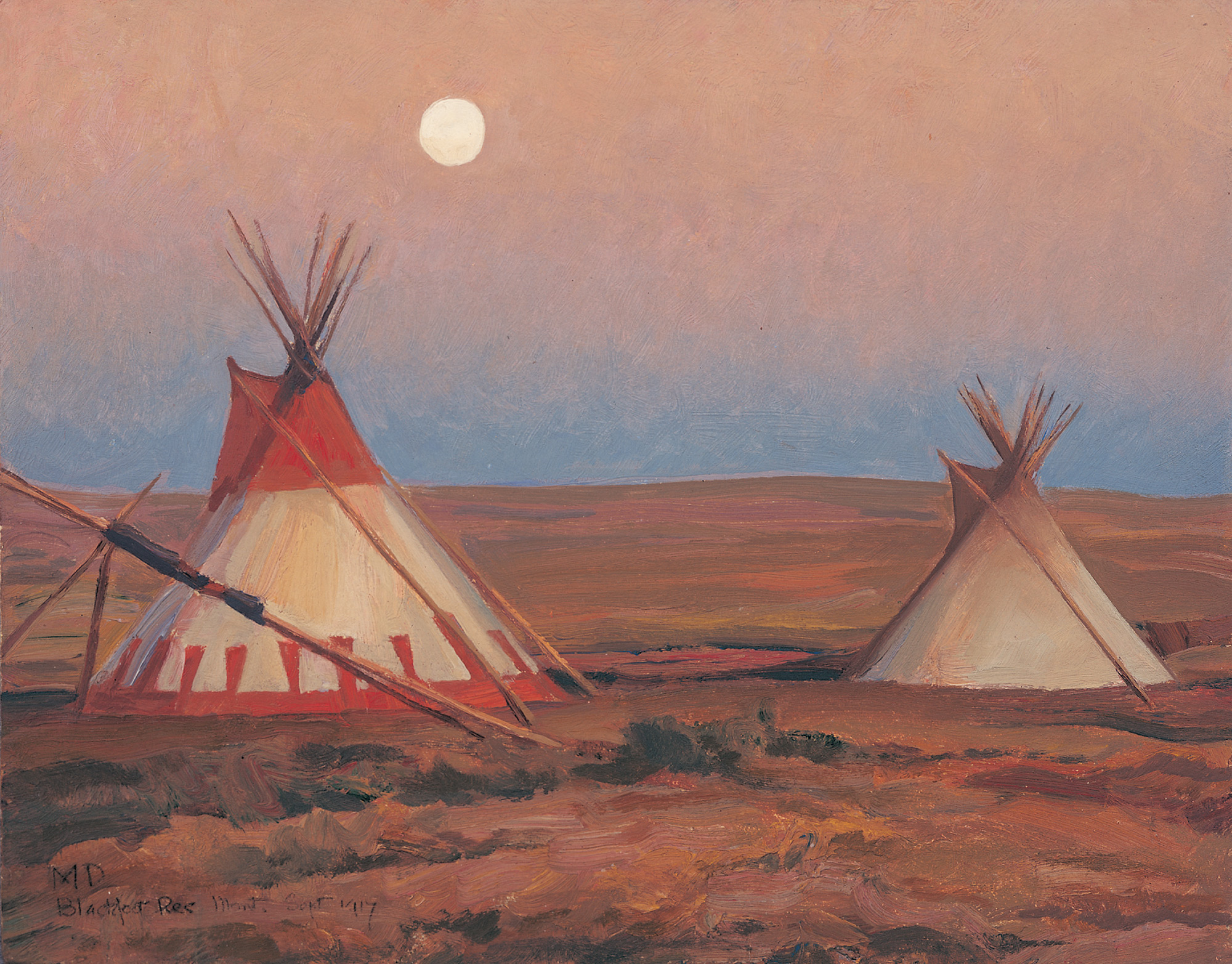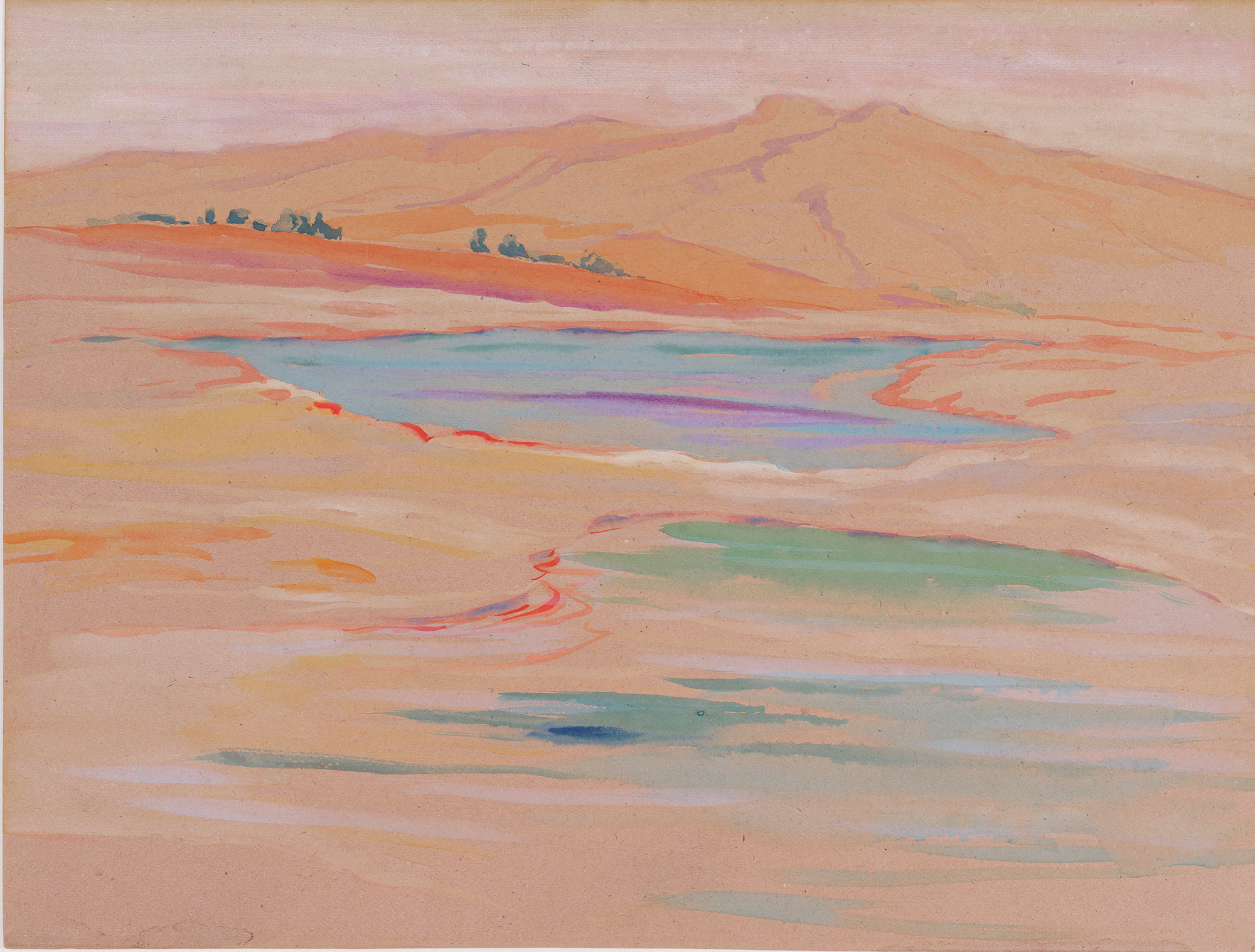
26 Jul Freeze Frame: The Art of the Parks in 1916
QUALITY TIME IN THE CHOICE WILD PLACES of the world, John Muir once said, doesn’t get subtracted from one’s allotted span. I hope he was right because in the past couple of years I’ve spent a lot of time in some of the famed crown jewel national parks. I’ve toured Arches in Utah for the first time in years, slogged through summer heat in the badlands of the Petrified Forest in Arizona, hiked the crater of Kilauea Iki in Volcanoes National Park on Hawaii, and of all the good luck have twice been in the Grand Canyon: an 18-day float through the red gorge the autumn of 2014, and a rim-to-rim day hike last October. If Muir was right, the world’s first national park system — whose official founding exactly 100 years ago ought to be causing all humans to genuflect reverently in the direction of history — could produce a whole nation of 100-year-olds, craggy but happy at all the wilderness blisters they’ve accumulated.
Two Septembers ago I was in the paterfamilias of them all, Yellowstone National Park, to watch wolves and coyotes (and grizzlies, it turned out) in the Lamar Valley. Writing a line like that, of course, has only been possible for the past two decades. A hundred years ago, when Congress passed the enabling act establishing a National Park Service, a few of those animals still roamed Yellowstone, but the roadside wolf-watching crowds I joined in 2013 did not exist and could not have. Peering through a spotting scope as the wolves of the Junction Butte pack shared their kills (and, I’ll admit, reflecting on the irony of us wolf watchers renting rooms in a hotel whose manager appeared in the Cooke City bars at night wearing a “Smoke A Pack A Day” t-shirt), had me thinking how much parks like Yellowstone and Glacier have changed since 1916, especially as we take them in visually. Seeing wolves in 2016 when precious few people ever did in 1916 is a surprising turn, and it sends me curiously to the art of these two parks from a century ago. How did they appear to discerning eyes then? What grand subjects arrested the eye in Yellowstone or Glacier in 1916 the way wolves are captivating us now? Would our present, wilder, parks have even seemed a possibility a century ago? It seems good to think about such things occasionally.
The artistic representation of these two crown jewel parks, circa 1916, one then almost brand-new, the other with half a century of history behind it, came to the world from the palettes of some of the most skillful American painters of the time. With Glacier nearly a stepchild of the Great Northern Railroad, James J. Hill and Louis Hill played patrons to the savants, assisting dozens of artists in visiting and portraying Glacier (so long as they were willing to cater to the Hills’ vision of a Switzerland with Indians). That lured out people like the great Western illustrator Maynard Dixon, the talented Los Angeles painter Kathryn Leighton, and the man Louis Hill finally settled on as his greatest discovery, the German portraitist Winold Reiss.
Yellowstone had no patron quite so invested (smothering?) as Louis Hill. But during the teen years, when Yellowstone finally got a national park system to join, three who stand out among the many who painted the park were Oscar Berninghaus, looking north from his perch with the Taos Society of Artists; a famous art professor from back East, Arthur Dow; and another Western artist almost as famous as Maynard Dixon, William Robinson Leigh. What all these artists captured circa 1916 might seem like nature in freeze frame, preserved so since Genesis. But the real truth, with 100 years of reflection to arrive at it, is that their work was more like a snapshot of a speeding bullet. What Berninghaus, Leigh, and the others captured was a portrayal of Glacier and Yellowstone nature in the act of becoming. The geographic space was the same in 1916 as it is in 2016. The hand of American culture would be on the tiller of these parks across a century’s time, though, so the most compelling visions of the parks have become very different.
America’s national parks were the first ones of the modern world. They had no real template to follow; they were the template. It was world-class landscape — scenery — that park proponents believed was the most important value in setting aside a national park. When wealthy New Englander Stephen Mather became the first director of the new National Park Service in 1916, he quickly moved to codify what almost all American parks advocates have endorsed ever since Yellowstone. National parks were supposed to preserve the best America had to offer — the best scenery, that is — for the perpetual enjoyment of the public.
And what was America’s best scenery? While there was no template for national parks, there was a template for scenery, and it came straight from the European Romantic movement. The best scenery was supposed to rise to an aesthetic level called “the sublime.” Romantics believed that sublimity was an emotional state one felt in the presence of God, and that the reason wilderness landscapes produce such feelings was they represented fresh examples of Creation. Philosopher Immanuel Kant explained in his Critique of Judgment that the sublime was “a feeling of displeasure from the inadequacy of the imagination.” By the standards of 19th century Old World tastes, the most sublime landscapes were the noisiest — with waterfalls and grand weather — the most operatic. Almost always they were landscapes of great vertical relief that left humans feeling dwarfed in the presence of scale and the eternal. In North America that meant mountain ranges and plunging canyons.
Thus Yellowstone and Glacier and Rocky Mountain, and Yosemite, Zion, and the Grand Canyon, all of which became our ne plus ultra examples of American national parks. As scenery they were all monumental, grandiloquent. But not merely that: They were sublimely, monumentally vertical, an idea that in American park history had a long reach. The first American to call for “a great nation’s park,” 1830s painter George Catlin, had in fact argued for something much more 21st century, what we would now call a grand “wildlife park,” the preservation of a 10,000-year-old ecology on America’s version of the Serengeti, the Great Plains. But plains country was not vertical; it did not speak to a Euro-American nature aesthetic based on alpine peaks and plunging gorges.
Nor did American wildlife, actually, which — if you know that — allows for a bit of a fresh view of the century-old art of Glacier and Yellowstone. As the southwestern railroads had done, the Great Northern line — or more specifically Louis Hill, son of line founder James J. Hill — wanted to use famous artists to help establish Glacier National Park as a premier vacation destination. As part of its See America First campaign, the railroad built Swiss chalets in Glacier to house tourists and hired local Blackfeet to entertain them. The idea, apparently, was to have the public imagine Glacier as the Alps, but with Indians. Glacier’s self-projection to the world in 1916 was not of preserved wildlife, not of a park as intact ecology. At a time when the world was still figuring out what America looked like, Glacier was an image of Indians in a sublime, Alps-like landscape.
Within three years of the Park Service Organic Act in 1916, Hill had picked his men. One was the New York painter Winold Reiss, a German portraitist whose gorgeous, chromatic portraits of local Blackfeet would become the face of Glacier Park for the next three decades. The other was one of the West’s most famous illustrator-painters, San Francisco artist Maynard Dixon. With Dixon, the plan was to have the painter visit and produce a set of large oils for Glacier’s lodges and for use as advertising posters. Dixon duly came in 1917, painted a dozen works he sent to St. Paul in 1918. Dispatched on to Glacier, somehow they disappeared en route and no one has located them to this day. It’s one of the enduring mysteries of national park art. But years later, in 1938, Dixon sat down in his studio and re-created the world of his 1917 Glacier visit with a single painting that is one of the best pieces of visual art to come out of the 20th century West. Dixon’s Home of the Blackfeet does something else, too. Like a stop-bath in old school photographic printing, it fixes an image of a moment in time.
And so, too, I think, does Los Angeles painter Kathryn Leighton’s masterpiece of the early years of the park, Grinnell Glacier, a painting that is the emblematic perfection of the American sublime landscape on canvas. So carry this image of sublime nature in the mind and proceed 250 miles south to Yellowstone, where 100 years ago Native Americans played no role at all in park imagery, but Leighton’s kind of vision most certainly did.
Visiting Yellowstone the summer before Congress would join our first park into a national park system, William Robinson Leigh sought out the kiva sipapu of the northern West, the very scene of Thomas Moran’s operatic 1872 painting. It was the Grand Canyon of the Yellowstone River that gave our first park an identity. Actually, Leigh was an accomplished wildlife painter who regarded himself as one of an elite trio of Western artists that included Remington and Russell. Yet in 1915, confronted with the famous foundational park, Leigh decided that essential Yellowstone imagery had not changed over the previous five decades. Since Yellowstone and sublime scenery were synonymous, Leigh seemed to have no choice: not animals but a grand landscape. Lower Falls of the Yellowstone became his valentine to the park 100 years ago.
The St. Louis, Missouri, artist Oscar Berninghaus, who had made a name for himself and for the Southwest by joining the hive of painters clustered in Taos, New Mexico, saw things from a different vantage. Namely, he saw from half the West away. Apparently Berninghaus believed he scarcely needed to visit Yellowstone to understand another of the key elements that made our national parks one of the country’s best ideas. So Berninghaus’s Old Faithful, Yellowstone (1914), painted from research rather than life, celebrated democratic access. To the famed Southwestern painter, it was Yellowstone’s ability to make the sublime accessible to Everyman that was the essential image of the park at the time of the Organic Act.
Arthur Wesley Dow’s Yellowstone National Park, one of several contemplative watercolors the famed Columbia University art instructor completed in the fall of 1917 during a visit to the park, added still another element to the visual imagery of Yellowstone. Not only was the National Park Service barely a year old in 1917, America’s entry into the Great War was even more recent. In Portland the professor had just given a lecture — “Art in Relation to Preparedness, Patriotism and Nationalism” — that undoubtedly influenced how he saw the country’s seminal park. Influenced by Japanese art, Dow’s painting is the opposite of noisy or theatrical. It is ethereal, instead, almost spiritual, a vision of a national landscape worth circling the wagons around. If Leigh saw God in Yellowstone and Berninghaus saw Democracy, for Dow there was something intrinsically American there worthy of Patriotism with a capital P.
Looking back on these artistic visions now, 100 years of time has somehow changed the parks into different places. Old Faithful still erupts, and the Grand Canyon of the Yellowstone still thrills the masses, but today an imagery centered on ecology — especially ecological change — seems to trump the sacred sublime, the West’s Native American legacy, even democratic access to and patriotism about our iconic national landscapes. The national parks are still one of America’s best ideas, but in 2016, the most noteworthy visions that Glacier and Yellowstone project into the culture have to do with how long Grinnell Glacier can last in a warming world, and just how far the cascade of ecological effects will ultimately extend from the gray wolf reintroduction to Yellowstone in 1995.
This is how history works, of course. Who can say now what visions will characterize the national parks 100 years in the future? Or whether any clues about that even exist yet? In 1916, during the exact years Dixon and Dow and the other artists here were doing their freeze frame portraits of Glacier and Yellowstone, the scientist Joseph Grinnell — the cousin of Grinnell Glacier’s namesake — advised the new National Park Service that instead of killing off predators, it ought to leave them “unmolested and allowed to retain their primitive relation to the rest of the fauna.” In fact, Grinnell wrote (at a time when Yellowstone and Glacier were targeting gray wolves and coyotes for complete extermination), for park tourists “the predatory animals [are] exceedingly interesting.”
It turned out this would be an insight into a widespread imagery the 21st century national parks would project. But in 1916, with a brand-new agency that was awash in visions of the sublime, of democracy, and of patriotism, who could have predicted that?
- Maynard Dixon | “Evening on Blackfoot Reservation” (detail) | Oil on Canvas | 10”x 14”
- Arthur Wesley Dow | “Yellowstone National Park” (detail) | 17 3/8” x 23 3/8”






No Comments